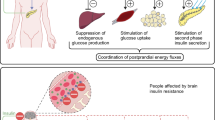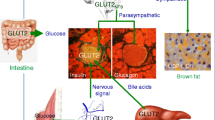Abstract
Cytosolic NADHcytochromeb5oxidoreductase (NCB5OR) is ubiquitously expressed in animal tissues. We have previously reported that global ablation of NCB5OR in mice results in early-onset lean diabetes with decreased serum leptin levels and increased metabolic and feeding activities. The conditional deletion of NCB5OR in the mouse cerebellum and midbrain (conditional knock out, CKO mice) results in local iron dyshomeostasis and altered locomotor activity. It has been established that lesion to or removal of the cerebellum leads to changes in nutrient organization, visceral response, feeding behavior, and body weight. This study assessed whether loss of NCB5OR in the cerebellum and midbrain altered feeding or metabolic activity and had an effect on serum T3, cortisol, prolactin, and leptin levels. Metabolic cage data revealed that 16 week old male CKO mice had elevated respiratory quotients and decreased respiratory water expulsion, decreased voluntary exercise, and altered feeding and drinking behavior compared to wild-type littermate controls. Most notably, male CKO mice displayed higher consumption of food during refeeding after a 48h fast. Echo MRI revealed normal body composition but decreased total water content and hydration ratios in CKO mice. Increased serum osmolality measurements confirmed the dehydration status of male CKO mice. Serum leptin levels were significantly elevated in male CKO mice while prolactin, T3, and cortisol levels remain unchanged relative to wild-type controls, consistent with elevated transcript levels for leptin receptors (short form) in the male CKO mouse cerebellum. Taken together, these findings suggest altered feeding response post starvation as a result of NCB5OR deficiency in the cerebellum.







Similar content being viewed by others
References
Stroh M, Swerdlow RH, Zhu H. Common defects of mitochondria and iron in neurodegeneration and diabetes (MIND): a paradigm worth exploring. Biochem Pharmacol. 2014;88(4):573–83.
Zhu H, Qiu H, Yoon HW, Huang S, Bunn HF. Identification of a cytochrome b-type NAD(P)H oxidoreductase ubiquitously expressed in human cells. Proc Natl Acad Sci U S A. 1999;96(26):14742–7.
Zhu H, et al. NCB5OR is a novel soluble NAD(P)H reductase localized in the endoplasmic reticulum. J Biol Chem. 2004;279(29):30316–25.
Kalman FS, et al. Natural mutations lead to enhanced proteasomal degradation of human Ncb5or, a novel flavoheme reductase. Biochimie. 2013;95(7):1403–10.
Zhu H, Wang WF, Wang HP, Xu M, E L, Swerdlow RH. Impaired iron metabolism in monogenic Ncb5or diabetes. Diabetes. 2013;62:556–87. (Abstract)
Xu M, et al. Ncb5or deficiency increases fatty acid catabolism and oxidative stress. J Biol Chem. 2011;286(13):11141–54.
Guo Y, et al. Beta-cell injury in Ncb5or-null mice is exacerbated by consumption of a high-fat diet. Eur J Lipid Sci Technol. 2012;114(3):233–43.
Larade K, et al. Loss of Ncb5or results in impaired fatty acid desaturation, lipoatrophy, and diabetes. J Biol Chem. 2008;283(43):29285–91.
Xie J, et al. Absence of a reductase, NCB5OR, causes insulin-deficient diabetes. Proc Natl Acad Sci U S A. 2004;101(29):10750–5.
Stroh MA, Winter MK, Swerdlow RH, McCarson KE, Zhu H. Loss of NCB5OR in the cerebellum disturbs iron pathways, potentiates behavioral abnormalities, and exacerbates harmaline-induced tremor in mice. Metab Brain Dis. 2016;31:951–64.
Mendoza J, Pevet P, Felder-Schmittbuhl MP, Bailly Y, Challet E. The cerebellum harbors a circadian oscillator involved in food anticipation. J Neurosci. 2010;30(5):1894–904.
Zhu JN, Wang JJ. The cerebellum in feeding control: possible function and mechanism. Cell Mol Neurobiol. 2008;28(4):469–78.
Kim JG, Jung HS, Kim KJ, Min SS, Yoon BJ. Basal blood corticosterone level is correlated with susceptibility to chronic restraint stress in mice. Neurosci Lett. 2013;555:137–42.
Nakamura K, et al. Effect of food-restriction stress on immune response in mice. J Neuroimmunol. 1990;30(1):23–9.
Gong S, et al. Dynamics and correlation of serum cortisol and corticosterone under different physiological or stressful conditions in mice. PLoS One. 2015;10(2):e0117503.
Dietrichs E, Haines DE, Roste GK, Roste LS. Hypothalamocerebellar and cerebellohypothalamic projections—circuits for regulating nonsomatic cerebellar activity? Histol Histopathol. 1994;9(3):603–14.
Haines DE, Dietrichs E, Mihailoff GA, McDonald EF. The cerebellar-hypothalamic axis: basic circuits and clinical observations. Int Rev Neurobiol. 1997;41:83–107.
Zhu JN, Yung WH, Kwok-Chong Chow B, Chan YS, Wang JJ. The cerebellar-hypothalamic circuits: potential pathways underlying cerebellar involvement in somatic-visceral integration. Brain Res Rev. 2006;52(1):93–106.
Hoche F, Guell X, Sherman JC, Vangel MG, & Schmahmann JD. Cerebellar contribution to social cognition. Cerebellum. 2016;15(6):732–743.
Korenaga K, et al. Clinical usefulness of non-protein respiratory quotient measurement in non-alcoholic fatty liver disease. Hepatol Res. 2013;43(12):1284–94.
Nakaya Y, et al. Respiratory quotient in patients with non-insulin-dependent diabetes mellitus treated with insulin and oral hypoglycemic agents. Ann Nutr Metab. 1998;42(6):333–40.
Antunes-Rodrigues J, de Castro M, Elias LL, Valenca MM, McCann SM. Neuroendocrine control of body fluid metabolism. Physiol Rev. 2004;84(1):169–208.
Franci CR, Kozlowski GP, McCann SM. Water intake in rats subjected to hypothalamic immunoneutralization of angiotensin II, atrial natriuretic peptide, vasopressin, or oxytocin. Proc Natl Acad Sci U S A. 1989;86(8):2952–6.
Daniels D. Angiotensin II (de)sensitization: fluid intake studies with implications for cardiovascular control. Physiol Behav. 2016.
Thornton SN. Angiotensin inhibition and longevity: a question of hydration. Pflugers Archiv-Eur J Physiol. 2011;461(3):317–24.
Lenkei Z, Palkovits M, Corvol P, Llorens-Cortes C. Expression of angiotensin type-1 (AT1) and type-2 (AT2) receptor mRNAs in the adult rat brain: a functional neuroanatomical review. Front Neuroendocrinol. 1997;18(4):383–439.
Huang Z, et al. Immunohistochemical detection of angiotensin II receptors in mouse cerebellum and adrenal gland using “in vivo cryotechnique”. Histochem Cell Biol. 2013;140(4):477–90.
Parsons LM, et al. Neuroimaging evidence implicating cerebellum in support of sensory/cognitive processes associated with thirst. Proc Natl Acad Sci U S A. 2000;97(5):2332–6.
Wen YQ, Zhu JN, Zhang YP, Wang JJ. Cerebellar interpositus nuclear inputs impinge on paraventricular neurons of the hypothalamus in rats. Neurosci Lett. 2004;370(1):25–9.
Santollo J, Daniels D. Control of fluid intake by estrogens in the female rat: role of the hypothalamus. Front Syst Neurosci. 2015;9:25.
Santollo J, Daniels D. Multiple estrogen receptor subtypes influence ingestive behavior in female rodents. Physiol Behav. 2015;152(Pt B):431–7.
Xue B, Johnson AK, Hay M. Sex differences in angiotensin II- and aldosterone-induced hypertension: the central protective effects of estrogen. Am J Physiol Regul Integr Comp Physiol. 2013;305(5):R459–63.
Keller U, Szinnai G, Bilz S, Berneis K. Effects of changes in hydration on protein, glucose and lipid metabolism in man: impact on health. Eur J Clin Nutr. 2003;57(Suppl 2):S69–74.
Kalra B, Gefen E. Scorpions regulate their energy metabolism towards increased carbohydrate oxidation in response to dehydration. Comp Biochem Physiol A Mol Integr Physiol. 2012;162(4):372–7.
Logan-Sprenger HM, Heigenhauser GJ, Jones GL, Spriet LL. The effect of dehydration on muscle metabolism and time trial performance during prolonged cycling in males. Physiol Rep. 2015;3(8)
Diaz-Munoz M, Vazquez-Martinez O, Aguilar-Roblero R, Escobar C. Anticipatory changes in liver metabolism and entrainment of insulin, glucagon, and corticosterone in food-restricted rats. Am J Physiol Regul Integr Comp Physiol. 2000;279(6):R2048–56.
Friedman JM, Halaas JL. Leptin and the regulation of body weight in mammals. Nature. 1998;395(6704):763–70.
van Swieten MMH, Pandit R, Adan RAH, van der Plasse G. The neuroanatomical function of leptin in the hypothalamus. J Chem Neuroanat. 2014;61-62:207–20.
Bennett PA, et al. Differential expression and regulation of leptin receptor isoforms in the rat brain: effects of fasting and oestrogen. Neuroendocrinology. 1998;67(1):29–36.
Burguera B, et al. The long form of the leptin receptor (OB-Rb) is widely expressed in the human brain. Neuroendocrinology. 2000;71(3):187–95.
Guan XM, Hess JF, Yu H, Hey PJ, Vander Ploeg LHT. Differential expression of mRNA for leptin receptor isoforms in the rat brain. Mol Cell Endocrinol. 1997;133(1):1–7.
Berman SM, et al. Effects of leptin deficiency and replacement on cerebellar response to food-related cues. Cerebellum. 2013;12(1):59–67.
Oldreive CE, Harvey J, Doherty GH. Neurotrophic effects of leptin on cerebellar Purkinje but not granule neurons in vitro. Neurosci Lett. 2008;438(1):17–21.
Fukushima A, et al. Sex differences in feeding behavior in rats: the relationship with neuronal activation in the hypothalamus. Front Neurosci. 2015;9:88.
Forbes S, Herzog H, Cox HM. A role for neuropeptide Y in the gender-specific gastrointestinal, corticosterone and feeding responses to stress. Br J Pharmacol. 2012;166(8):2307–16.
Brandebourg TD, Bown JL, Ben-Jonathan N. Prolactin upregulates its receptors and inhibits lipolysis and leptin release in male rat adipose tissue. Biochem Biophys Res Commun. 2007;357(2):408–13.
Fitzgerald P, Dinan TG. Prolactin and dopamine: what is the connection? A review article. J Psychopharmacol. 2008;22(2 Suppl):12–9.
Sirotkin AV, et al. Effects of chronic food restriction and treatments with leptin or ghrelin on different reproductive parameters of male rats. Peptides. 2008;29(8):1362–8.
Watanobe H, Schioth HB, Suda T. Stimulation of prolactin secretion by chronic, but not acute, administration of leptin in the rat. Brain Res. 2000;887(2):426–31.
DiLeone RJ. The influence of leptin on the dopamine system and implications for ingestive behavior. Int J Obes. 2009;33:S25–9.
Fernandes MF, et al. Leptin suppresses the rewarding effects of running via STAT3 signaling in dopamine neurons. Cell Metab. 2015;22(4):741–9.
Ikai Y, Takada M, Shinonaga Y, Mizuno N. Dopaminergic and non-dopaminergic neurons in the ventral tegmental area of the rat project, respectively, to the cerebellar cortex and deep cerebellar nuclei. Neuroscience. 1992;51(3):719–28.
Kim KS, et al. Enhanced hypothalamic leptin signaling in mice lacking dopamine D2 receptors. J Biol Chem. 2010;285(12):8905–17.
Cuevas S, Yang Y, Upadhyay K, Armando I, & Jose P (2014) Dopamine D2 receptors regulate leptin and IL-6 in 3T3 L1 adipocytes. Faseb J 28(1), 1107.5.
Acknowledgements
Authors would like to thank Dr. Jennifer Knapp at University of Kansas Medical Center (KUMC) for assistance with the alternative statistical analysis and Pearson correlation analysis. Authors acknowledge Dr. WenFang Wang (KUMC) for preparing the Ncb5or-floxed line for crossing and Dr. Alexandra Joyner at Memorial Sloan-Kettering Cancer Center for providing the En1-cre driver.
Funding
This project was supported by the School of Health Professions research funds (H.Z.) and the Kansas Intellectual and Developmental Disabilities Research Center (NIH HD002528 and HD090216) at KUMC. M.A.S was supported by a Ruth L. Kirschstein National Research Service Award (NIH T32 HD057850, PI: R. Nudo). J.P.T was supported by NIH DK-088940 and VA Merit Review I01 RX000123.
Author information
Authors and Affiliations
Corresponding author
Ethics declarations
Conflict of Interest
The authors declare that they have no conflict of interest.
Electronic supplementary material
ESM 1
(DOCX 772 kb)
Rights and permissions
About this article
Cite this article
Stroh, M.A., Winter, M.K., McCarson, K.E. et al. NCB5OR Deficiency in the Cerebellum and Midbrain Leads to Dehydration and Alterations in Thirst Response, Fasted Feeding Behavior, and Voluntary Exercise in Mice. Cerebellum 17, 152–164 (2018). https://doi.org/10.1007/s12311-017-0880-7
Published:
Issue Date:
DOI: https://doi.org/10.1007/s12311-017-0880-7




